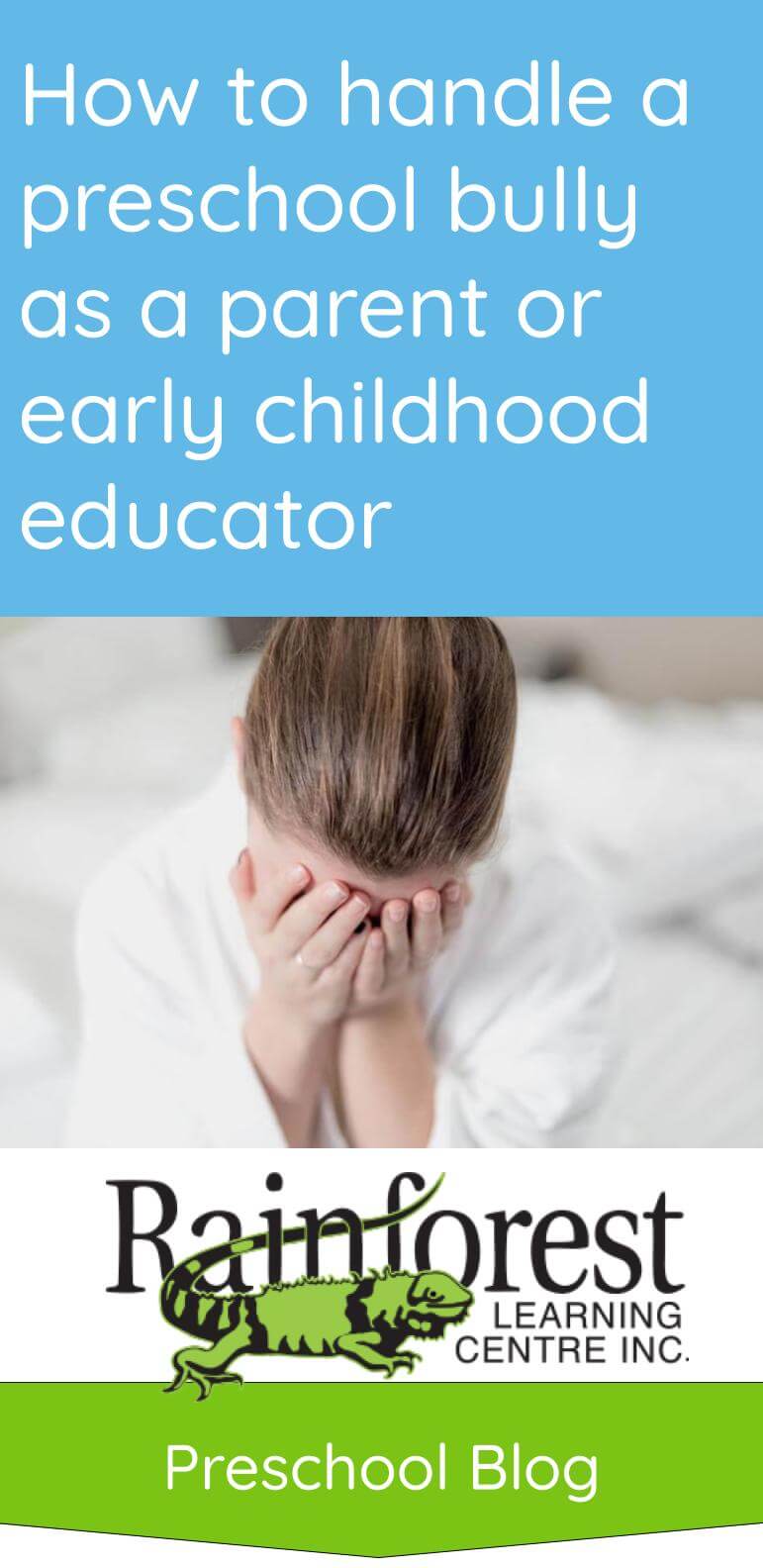
It may be surprising to know that bullying can start at a young age. Even three and four year olds can be mean and hurtful – as innocent as we often think they are.
Of course, this situation is hardest on the victim. Can you imagine being a little kid, venturing into the world without your parents, then being bullied, and not understanding why?
The parent pain follows – no mom or dad wants to see their child in this condition.
Finally, when you’re an early childhood educator or preschool teacher, this can put you in a tough spot, because you’ll be called on to mediate.
Treading carefully is important when dealing with a preschool bully. Remember, these behaviours are stemming from somewhere. And, while the victim of bullying should be protected at great lengths, there is still the other side to consider: how did the bully come to be like this? How can we work with parents to solve it, in the interest of all children in the classroom? There is usually always a story behind these situations, especially at such a young age. And, these problems are not solved overnight.
So, in this article, we’ll give some tips on how to handle a preschool bully as a parent or early childhood educator.
For parents: notice the signs of bullying and being bullied, when a preschooler is in their home environment, then work collaboratively to solve it
When a child is being bullied, especially in preschool or daycare, it can be really hard for them to talk about it. This is when children are first learning how to talk with more words, let alone name their complicated feelings (which we adults sometimes have trouble with). When children are mistreated, especially so early in life, they may come to think this behaviour is ‘normal.’ Or that it’s their fault. Worse: they may even emulate it.
So, parents of toddlers and preschoolers need to have their ‘spidey senses’ on as much as possible. Certainly, the preschool teacher or daycare provider will need to be on top of bullying. But, the truth is, it doesn’t always happen in plain sight, according to this article. So, it’s possible that it’s being overlooked, innocently.
Some of the common ways young children may express distress over being bullied include:
- Not wanting to go to school, or complaining they are sick to get out of going to school. Notice this especially if they initially loved school (but know that bullying only needs to be ruled out, not assumed to be the only cause).
- Not wanting to talk to you about how school was, or being strangely silent about it, when they are normally open about that information.
- Becoming sad, insecure or angry most of the time. Also notice when small things create triggers for the child, such as unexplained bouts of crying, or expressing helplessness.
- Strangely turning into a bully at home, when you are sure the things they say and do are not from your home environment.
- Telling stories about bullying scenarios, or playing them out with their toys, or in role play.
For parents and educators: Talk openly about preschool bullying and emphasize appropriate and inappropriate behaviours
If you want a victim of a preschool bully to report what is happening to you, they need to know that they can. They need to know they are in safe hands, and they won’t be ignored or put down for not being strong enough to stand up to the bully in the first place.
Remember: the bully has probably been lowering the self esteem of their victim. They may be calling them a ‘tattle tale’ or a ‘cry baby.’ They may be trying to isolate the child from other relationships, or threatening to ‘tell on’ on the child for something (and even lie about it).
As a four or five-year-old who doesn’t know any better, it’s easy to believe these erroneous things. So, speaking up is really hard.
The way to treat the ‘no talking’ issue is with prevention. This starts with open lines of communication between a parent and child, and the preschool teacher and the classroom.
To do this well, parents and teachers first need to be fully educated about all aspects of bullying in early childhood. It is not that simple, since it can be picked up early in life, and is not always ‘seen.’ Thereafter, some measures can be taken to prevent it.
Preschool teachers need to:
- In circle time, define and label both pre-bullying and bullying behaviours, so they are not abstract ideas. For example, telling a peer, “you’re not allowed to play with us,” or assigning them the undesirable roles in role playing all the time is bullying. It doesn’t have to be just shoving and taking toys away from one another. It can be more subtle than that. Here are great worksheets to help with preschool lessons on bullying.
- Call out bullying behaviours and ensure there are classroom rules, with age-appropriate consequences. When the children are playing, and one of them is left out, or called a name, or their lunch or toy is stolen, put an end to it, abruptly. As the adult in this situation, you’re the only one with the authoritative power to do something to protect the victim, and to teach the bully – and the class – that this behaviour won’t be tolerated. This is a ‘teachable moment,’ so the opportune time to deal with it, is when it happens.
- Encourage and praise positive behaviours among children in the classroom. When kids are being nice to each other, by sharing, helping, saying nice things, including someone who may feel left out, etc. – say something. Let the kiddos know that you are noticing, and you appreciate it.
- Ensure the entire class knows that when it comes to bullying, there’s no such thing as a ‘tattle tale.’ Tell them, as a class, that you want to know about it, if it happens. Also, when you do get told, don’t ignore it, or put it off. Don’t make a scene either, which will embarrass the victim.
Parents need to:
- Develop loving, nurturing and healthy parent-child relationships. When children grow up in authoritarian households, or in environments where children are to be ‘seen and not heard,’ this can have lasting impacts on a child, and their behaviours.
- Create positive home environments and be a role model. If there is a lot of yelling and fighting in your family, chances are, your kids will pick up on that. It can lead to aggressive behaviours. You may need to start seeing a family therapist. Start by speaking to your doctor about this issue, and what your next steps can be to solve it.
- Actively ask their children about their day. Children need to know that you want to hear about their lives, and what matters to them. Don’t always wait for them to initiate conversation. Show an interest in them, and their tiny little world, by asking them questions. A great time to do this is at the dinner table, or when tucking them into bed, or even just on a one-on-one outing with them. The more they know they can talk to you about anything, the higher chance they’ll want to tell you about a bully.
- Be prepared for an appropriate response when learning about a preschool bully. Sometimes, when a parent overreacts, or under-reacts, a child may regret telling them the truth about something. So, if you hear your child is being bullied (or even if they are being the bully), remember to stay calm, acknowledge the problem, let them know it’s not their fault, and that you want to be there to help them with it. From there, you can begin taking steps to solve the issue in a rational way. See more in this article.
See related on our blog:
- What is social competence in the early years?
- 3 ways early childhood educators can help kids get along and feel included
- 3 ways to build self-awareness in early childhood
- What is a balanced parenting style for toddlers and preschool-aged children? Here are 3 answers.
Also, we found the following excellent, comprehensive, and very articulate PDF about bullying in early childhood, which we recommend you take a look at, too:
http://eyesonbullying.org/pdfs/eob-early-childhood-508.pdf
For all adults: this is a collective issue, and it needs to be handled cooperatively
When there’s a preschool bully to deal with, the responsible adults need to work cooperatively to solve the problem.
The early childhood educator, the parents of the victim and the parents of the bully need to set aside ample time to have a conversation together – and probably multiple times too. If the parents of the ‘opposing’ parties are not keen on speaking with each other directly, the preschool teacher needs to be willing to speak to both sets of parents individually.
Now, we’ll be honest: this conversation doesn’t always go as idealistically as we’d like it to. In truth, parents can start a ‘blame game.’ And, if the bullying child is from an abrasive home, chances are, the parents are the root cause of the issue. So, they may not be the most cooperative, nor will they always be fully aware of how their actions, or their child’s actions, affect other people.
On the other hand, the parent of the victim needs to realize that the bully of their child is also a victim. They can’t be so quick to take matters into their own hands. The bullying, aggressive child needs help, too. They are also in pain. Their actions are not right, however. We can not ignore them.
In the end, the preschool teacher will need to make the final call. We recommend giving plenty of opportunities to the family and the bully to work through the issues. Recommend therapy to the family. Work with the bully one-on-one while they’re in your care. Try to be the ‘teacher of manners’ as much as possible. Your influence on a child may be more impactful than you may think.
If all else fails, you will have not choice but to ensure the emotional, psychological and physical safety of all children in your care. If that means the bully has to go, then that may be the only answer.
To conclude: preschool bullying can happen, and it is best treated with prevention and adult cooperation
As we’ve seen above, preschool bullying is definitely possible, no matter how innocent or harmless kids seem. We can’t take the approach that ‘kids will be kids’ or that they need to learn to stand up for themselves. While those things are true, they are not helpful in situations of serious bullying.
Parents and preschool teachers need to work together to ensure that bullying is being reported, and children feel safe to do the reporting. Then, they need to work together to address it rationally, and with the view of helping all the children involved – even the young bully.
As a last resort, a bully may need to be removed from the preschool classroom. However, comprehensive efforts should be made before reaching this point. Remember: the bully can be in pain, even if their actions are not right. We don’t tolerate the behaviour. But, with parent cooperation, we can try to ensure a preschool bully gets the help they need, so they can learn to manage their emotions in a healthy way.
See more on our blog:
